How To Find The Iqr Of A Data Set
What is an Interquartile Range?
The interquartile range is a measure of where the "middle fifty" is in a data set. Where a range is a measure of where the beginning and terminate are in a set, an interquartile range is a measure of where the bulk of the values prevarication. That'due south why information technology'southward preferred over many other measures of spread when reporting things like school operation or SAT scores.
The interquartile range formula is the offset quartile subtracted from the tertiary quartile:
Lookout man the video for how to calculate the interquartile range by hand:
How to detect an interquartile range
Can't see the video? Click hither.
Contents:
Solving by manus:
- Solve the formula by hand (odd set of numbers).
- What if I have an even set of numbers?
- Observe an interquartile range for an odd prepare of numbers: 2nd Method
- Box Plot interquartile range: How to find it
Using Technology:
- Interquartile Range in Minitab
- Interquartile Range in Excel
- Interquartile Range in SPSS
- Interquartile Range on the TI83
- Q1, Q3 and the IQR on the TI89
General info:
- What is an Interquartile range?
- What is the Interquartile Range Formula?
- IQR as a Test for Normal Distribution
- What is an Interquartile Range used for?
- History of the Interquartile Range.
Solve the formula by hand.
Steps:
- Stride 1: Put the numbers in order.
ane, 2, 5, half-dozen, 7, 9, 12, xv, 18, nineteen, 27. - Step 2: Find the median.
one, ii, v, half-dozen, 7, ix, 12, 15, eighteen, 19, 27. - Step three: Place parentheses around the numbers to a higher place and beneath the median.
Not necessary statistically, but it makes Q1 and Q3 easier to spot.
(one, 2, five, 6, vii), nine, (12, 15, 18, 19, 27). - Stride 4: Find Q1 and Q3
Think of Q1 as a median in the lower half of the information and think of Q3 as a median for the upper half of information.
(i, ii, 5, 6, vii), nine, ( 12, xv, eighteen, nineteen, 27). Q1 = 5 and Q3 = eighteen. - Stride v: Decrease Q1 from Q3 to discover the interquartile range.
xviii – v = 13.
Like the explanation? Check out the Practically Cheating Statistics Handbook, which has hundreds more footstep-by-pace explanations, but like this one!
What if I Have an Even Set of Numbers?
Example question: Notice the IQR for the post-obit data set: three, five, 7, 8, 9, 11, 15, sixteen, 20, 21.
- Pace one: Put the numbers in order.
3, 5, vii, 8, 9, xi, 15, 16, xx, 21. - Stride 2: Make a mark in the centre of the data:
three, 5, seven, viii, ix, | 11, 15, 16, twenty, 21. - Step three: Place parentheses around the numbers in a higher place and below the mark yous made in Step 2--it makes Q1 and Q3 easier to spot.
(iii, five, 7, 8, ix), | (11, xv, 16, 20, 21). - Footstep iv: Detect Q1 and Q3
Q1 is the median (the middle) of the lower half of the information, and Q3 is the median (the heart) of the upper half of the data.
(3, v, vii, eight, 9), | (11, 15, 16, 20, 21). Q1 = 7 and Q3 = 16. - Step v: Subtract Q1 from Q3.
xvi – 7 = 9.
This is your IQR.
Back to Top
Find an interquartile range for an odd set of numbers: Alternate Method
As you lot may already know, nothing is "fix in stone" in statistics: when some statisticians find an interquartile range for a set of odd numbers, they include the median in both both quartiles. For example, in the following set of numbers: one, 2, v, vi, vii, 9, 12, 15, eighteen, 19, 27 some statisticians would interruption it into two halves, including the median (ix) in both halves:
(i, ii, 5, 6, seven, 9), (nine, 12, 15, 18, 19, 27)
This leads to two halves with an even set of numbers, so you can follow the steps to a higher place to find the IQR.
Dorsum to Top
Box Plot interquartile range: How to discover it
Watch the video for the steps.
How to find an interquartile range on a boxplot
Can't see the video? Click here.
Box Plot interquartile range: How to find it
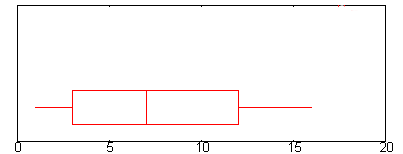
Instance question: Discover the interquartile range for the above box plot.
- Step i: Find Q1.Q1 is represented by the left hand edge of the "box" (at the point where the whisker stops).
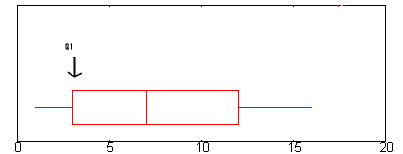
In the above graph, Q1 is approximately at 2.half-dozen. (A consummate explanation of Q1 is here: The five number summary.)
- Pace two: Notice Q3.
Q3 is represented on a boxplot by the right hand edge of the "box".
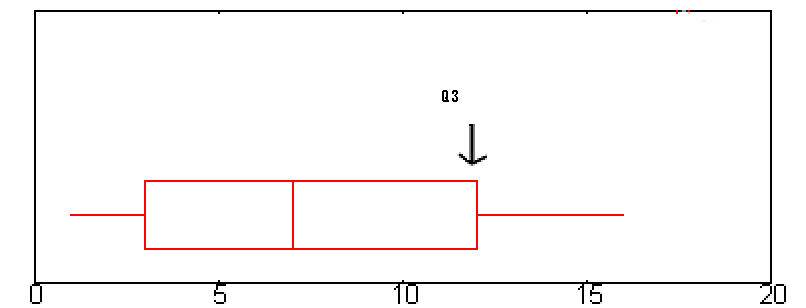
Q3 is approximately 12 in this graph. - Step iii: Subtract the number you found in stride ane from the number you found in step three.
This will give you the interquartile range. 12 – ii.6 = 9.4.
That's information technology!
Dorsum to Height
Interquartile Range in Minitab
Watch the video for stride-by-step directions:
How to find an interquartile range in Minitab
Can't see the video? Click here.
Interquartile Range in Minitab: Steps
Instance question: Find an interquartile range in Minitab for the Grade Betoken Average (GPA) in the following information fix:
Grade Point Average (GPA): 1(3.2), i(3.1), two(3.five), 2(2.0), three(i.9), 3(4.0), three(3.9), four(three.8), iv(2.ix), v(iii.nine), 5(3.ii), 5(3.three), 6(iii.four), 6(2.6), half dozen(2.5), 7(2.0), 7(1.5), 8(4.0), 8(2.0).
Stride 1: Type your information into a Minitab worksheet. Enter your data into one or 2 columns.
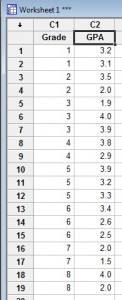
Footstep 2: Click "Stat," so click "Basic Statistics," and then click "Brandish Descriptive Statistics" to open the Descriptive Statistics carte.
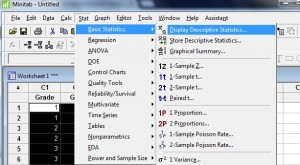
Step iii: Click a variable proper noun in the left window and then click the "Select" button to transfer the variable name to the right-paw window.
Step 4: Click the "Statistics" push button.
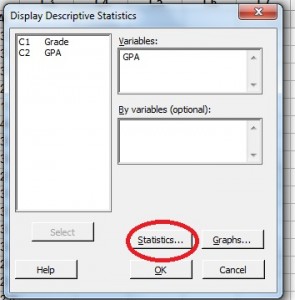
Step 5: Check "Interquartile Range."
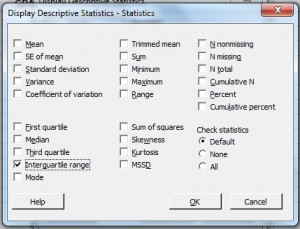 .
.
Step 6: Click the "OK" button (a new window will open up with the event). The IQR for the GPA in this particular data set is 1.8.
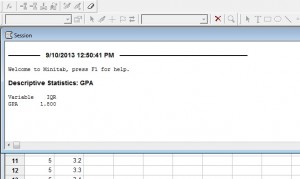
That's it!
Tip: If y'all don't see descriptive statistics show in a window, click "Window" on the toolbar, then click "Tile." Click the Session window (this is where descriptive statistics appear) and and so coil upward to see your results.
Back to Top
Interquartile Range in Excel 2007
How to Notice an Interquartile Range Excel 2007
Watch the video or read the steps beneath to find an interquartile range in Excel 2007:
How to find an interquartile range in Excel
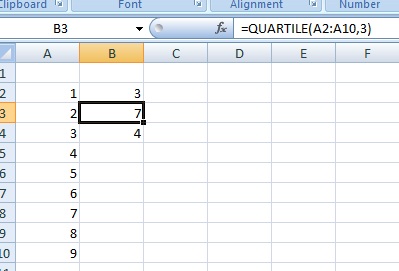
Steps:
Step one: Enter your information into a single Excel column on a worksheet. For example, type your data in cells A2 to A10. Don't leave any gaps in your data.
Step 2: Click a bare cell (for example, click cell B2) and then type =QUARTILE(A2:A10,i). You lot'll need to replace A2:A10 with the actual values from your data set. For example, if you typed your data into B2 to B50, the equation is =QUARTILE(B2:B50,1). The "ane" in this Excel formula(A2:A10,ane) represents the first quartile (i.e the bespeak lying at 25% of the data set).
Step 3: Click a second blank cell (for example, click prison cell B3) and then type =QUARTILE(A2:A10,three). Supervene upon A2:A10 with the bodily values from your information fix. The "iii" in this Excel formula (A2:A10,3) represents the third quartile (i.e. the point lying at 75% of the data set up).
Stride 4: Click a third blank jail cell (for example, click jail cell B4) and and so type =B3-B2. If your quartile functions from Step two and 3 are in dissimilar locations, change the cell references.
Pace 5: Press the "Enter" key. Excel will return the IQR in the cell you clicked in Step four
That'due south it!
Dorsum to Tiptop
How to Notice an Interquartile Range in SPSS
Like about technology, SPSS has several ways that you can calculate the IQR. Nevertheless, if yous click on the most intuitive way you lot would expect to detect it ("Descriptive Statistics > Frequencies"), the surprise is that it won't list the IQR (although it will list the kickoff, 2d and third quartiles). You could take this route and and so subtract the third quartile from the first to get the IQR. However, the easiest style to find the interquartile range in SPSS past using the "Explore" command. If you have already typed data into your worksheet, skip to Step 3.
Watch the video for the steps:
How to observe the Interquartile Range in SPSS
Tin't run across the steps? Click here.
Steps
Step ane: Open up a new data file in SPSS. Click "File," mouse over "New" and then click "Information."
Footstep ii: Type your data into columns in the worksheet. You can use as many columns as you need, but don't get out blank rows or spaces between your data. See: How to Enter Information into SPSS.
Footstep iii: Click "Clarify," then mouse over "Descriptive Statistics." Click "Explore" to open the "Explore" dialog box.
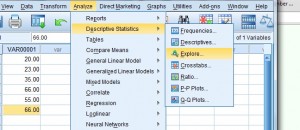
Pace 4: Click the variable proper noun (that's just a fancy proper name for the column heading), then click the elevation arrow to move the variable into the "Dependent list" box.
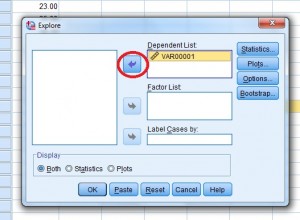
The "Explore" variables dialog box.
Pace 5: Click "OK." The interquartile range is listed in the Descriptives box.
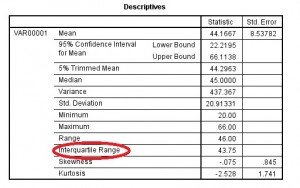
Tip: This instance has just one listing typed into the data canvass, just y'all may have several to cull from depending on how you entered your data. Make sure you select the right variable (column names) before proceeding. If you lot want more than memorable variable names, alter the cavalcade championship by clicking the "variable view" button at the very bottom left of the worksheet. Type in your new variable name and and then return to data view by clicking the "data view" push.
Dorsum to Peak
What is an Interquartile Range?
Imagine all the data in a set as points on a number line. For case, if you have iii, 7 and 28 in your fix of data, imagine them every bit points on a number line that is centered on 0 simply stretches both infinitely below zero and infinitely above zero. Once plotted on that number line, the smallest data point and the biggest data betoken in the gear up of data create the boundaries (i.eastward. a lower leap and an upper bound) of an interval of space on the number line that contains all information points in the ready. The interquartile range (IQR) is the length of the middle 50% of that interval of infinite.

The interquartile range is the center l% of a data fix. Box and whiskers image by Jhguch at en.wikipedia
If you lot want to know that the IQR is in formal terms, the IQR is calculated as: The difference betwixt the third or upper quartile and the first or lower quartile. Quartile is a term used to describe how to divide the set of data into four equal portions (think quarter).
IQR Example
If you have a set containing the information points 1, 3, 5, 7, viii, 10, xi and xiii, the kickoff quartile is 4, the second quartile is vii.5 and the third quartile is 10.v. Describe these points on a number line and you lot'll come across that those three numbers carve up the number line in quarters from one to 13. As such, the IQR of that data set is half-dozen.v, calculated as 10.5 minus 4. The outset and third quartiles are besides sometimes called the 25th and 75th percentiles because those are the equivalent figures when the data ready is divided into percents rather than quarters.
Back to Top
Interquartile Range using the TI83
Watch the video for the steps:
TI 83 Interquartile Range
Can't come across the video? Click hither.
While you can employ the nifty online interquartile range computer on this website, that might not exist an selection in a quiz or test. Virtually instructors let the use of a TI-83 on tests, and it's even i of the few calculators allowed in the AP Statistics exam. Finding the TI 83 interquartile range involves nothing more than entering your data list and pushing a couple of buttons.
Example problem: Discover the TI 83 interquartile range for the heights of the top x buildings in the world (as of 2009). The heights, (in anxiety) are: 2717, 2063, 2001, 1815, 1516, 1503, 1482, 1377, 1312, 1272.
Steps
Pace 1: Enter the to a higher place data into a list on the TI 83 calculator. Press the STAT button and then printing ENTER. Enter the first number (2717), and and so press ENTER. Continue entering numbers, pressing ENTER after each entry.
Step 2: Press the STAT push button.
Stride 3: Printing the correct arrow push (the arrow keys are located at the top right of the keypad) to select "Calc."
Step four: Press ENTER to highlight "1-Var Stats."
Step v: Press ENTER once again to bring upwardly a list of stats.
Step vi: Scroll down the list with the arrow keys to find Q1 and Q3. Write those numbers downward. You could copy and paste the numbers but unfortunately, Texas Instruments doesn't brand this easy:
- Use the pointer keys to place the cursor at the starting time of the
text that yous want to highlight. - Using the TI Keyboard, printing and hold down the Shift fundamental, and then use the arrow keys to highlight the text.
- Release the Shift primal and arrow fundamental.
The copy and paste menu should appear, enabling you to copy and paste the data. You lot would have to exercise this twice (returning to the HOME screen each time), so it's much faster just to write the numbers down.
Pace 7:Subtract Q1 from Q3 to find the IQR (strong>624 feet for this set of numbers).
That's information technology!
Back to Top
How to Find Q1, Q3 and the Interquartile Range TI 89
Instance problem: Find Q1, Q3, and the IQR for the following list of numbers: 1, nine, 2, 3, 7, viii, 9, 2.
Step 1: Press APPS. Scroll to Stats/List Editor (utilize the pointer keys on the keypad to whorl). Press ENTER. If you don't have the stats/listing editor y'all can download information technology here.
Step 2: Clear the list editor of data: press F1 8.
Step 3: Press Blastoff 9 ALPHA i ENTER. This names your list "IQ."
Step 4: Enter your numbers, i at a time. Follow each entry by pressing the ENTER key. For our group of numbers, enter
1,ix,2,3,seven,viii,nine,two
Step five: Press F4, then ENTER (for the one-var stats screen).
Step 6: Tell the estimator you want stats for the list called "IQ" past entering Blastoff ix Alpha ane into the "List:" box. The computer should automatically put the cursor there for you. Press ENTER twice.
Step 7: Read the results. Q1 is listed every bit Q1X (in our example, Q1X=2). Q3 is listed as Q3X (Q3X=eight.5). To detect the IQR, subtract Q1 from Q3 on the Dwelling house screen. The IQR is 8.5-two=vi.5.
That's it!
Back to Elevation
What is The Interquartile Range Formula?
The IQR formula is:
IQR = Q3 – Q1
Where Q3 is the upper quartile and Qi is the lower quartile.
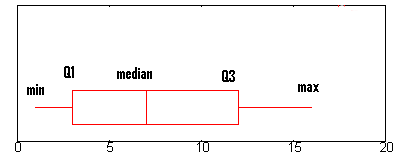
IQR as a test for normal distribution
Use the interquartile range formula with the hateful and standard divergence to examination whether or non a population has a normal distribution. The formula to make up one's mind whether or non a population is usually distributed are:
Q1 – (σ z1) + X
Q3 – (σ z3) + X
Where Qone is the first quartile, Q3 is the third quartile, σ is the standard deviation, z is the standard score ("z-score") and X is the mean. In gild to tell whether a population is unremarkably distributed, solve both equations and then compare the results. If there is a significant difference between the results and the first or 3rd quartiles, and so the population is not normally distributed.
Back to Top
What is an Interquartile Range Used For?
The IQR is used to measure how spread out the data points in a set are from the mean of the information gear up. The higher the IQR, the more spread out the information points; in dissimilarity, the smaller the IQR, the more bunched up the data points are around the mean. The IQR range is i of many measurements used to measure out how spread out the data points in a data fix are. It is best used with other measurements such as the median and full range to build a complete picture of a data fix'south tendency to cluster effectually its mean.
Back to Top
Where Does the term Interquartile Range Come From?
Who invented the term "Interquartile Range?" In order to find that out, we have to go dorsum to the 19th century.
History
British physician Sir Donald MacAlister used the terms lower quartile and higher quartile in the 1879 publication, the Police force of the Geometric Hateful. Proc. R. Soc. XXIX, p. 374: " "Every bit these two measures, with the mean, divide the curve of facility into 4 equal parts, I propose to phone call them the 'higher quartile' and the 'lower quartile' respectively."
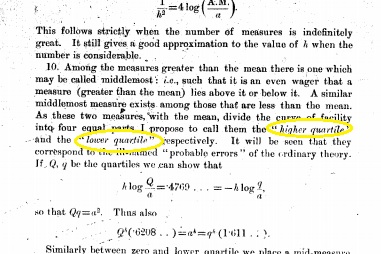
Although a physician past trade, he was gifted with mathematics and accomplished the highest score in the final mathematics exams at Cambridge University in 1877. He spoke nineteen languages including English, Czech and Swedish.
Macalister'due south paper, the Law of the Geometric Hateful was really in response to a question put forward by Francis Galton (inventor of the Galton lath). However, it wasn't until 1882 that Galton ("Written report of the Anthropometric Committee") used the upper quartile and lower quartile values and the term "interquartile range" —defined as twice the probable error. Galton wasn't just a statistician—he was also an anthropologist, geographer, proto-genetecist and psychometrician who produced more than 340 books. He also coined the statistical terms "correlation" and "regression toward the mean."
References
Gonick, L. and Smith, W. The Cartoon Guide to Statistics. New York: Harper Perennial, pp. 20-21, 1993.
---------------------------------------------------------------------------
Demand help with a homework or test question? With Chegg Study, y'all can get footstep-by-step solutions to your questions from an expert in the field. Your commencement xxx minutes with a Chegg tutor is free!
Comments? Need to post a correction? Please mail a comment on our Facebook page .
How To Find The Iqr Of A Data Set,
Source: https://www.statisticshowto.com/probability-and-statistics/interquartile-range/
Posted by: fairleyhusith.blogspot.com


0 Response to "How To Find The Iqr Of A Data Set"
Post a Comment